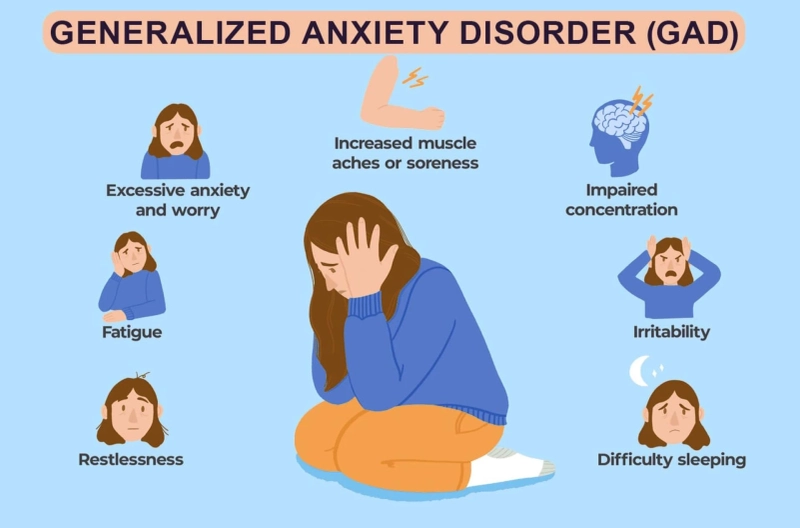Anxiety syndromes refer to a group of mental health disorders characterized by excessive and persistent anxiety and fear. Anxiety is a normal reaction to stress, and it can be useful in certain situations, such as preparing for a test or making an important decision. However, when anxiety becomes excessive, irrational, and interferes with daily activities, it may be a sign of an anxiety disorder.
Common Anxiety Syndromes:
This essay will discuss some of the most common Anxiety Syndromes, including generalized anxiety disorder (GAD), panic disorder, social anxiety disorder (SAD), and specific phobias.
Generalized Anxiety Disorder (GAD)
Generalized anxiety disorder is characterized by excessive and persistent worry and anxiety about various life events, such as work, relationships, and health. People with GAD often feel anxious most of the time and find it difficult to control their worries. Physical symptoms, such as muscle tension, fatigue, and headaches, may also be present. GAD affects approximately 3-5% of the population, and it is more common in women than in men.
Panic Disorder
Panic disorder is characterized by sudden and unexpected panic attacks, which are intense episodes of fear and physical symptoms, such as chest pain, sweating, and shortness of breath. Panic attacks can be so severe that people may feel like they are having a heart attack or dying. Panic disorder affects approximately 2-3% of the population, and it is more common in women than in men.
Social Anxiety Disorder (SAD)
Social anxiety disorder, also known as social phobia, is characterized by intense fear and avoidance of social situations, such as parties, public speaking, and meeting new people. People with SAD often fear being judged or embarrassed in social situations and may experience physical symptoms, such as blushing, sweating, and trembling. SAD affects approximately 7% of the population, and it is more common in women than in men.
Specific Phobias
Specific phobias are characterized by intense and persistent fear of specific objects or situations, such as spiders, heights, or flying. People with specific phobias may go to great lengths to avoid the object of their fear, and even thinking about it can trigger anxiety symptoms. Specific phobias affect approximately 12% of the population, and they are more common in women than in men.
Causes of Anxiety Syndromes
The exact causes of anxiety syndromes are not fully understood, but they are likely to be a combination of genetic, environmental, and psychological factors. Genetics may play a role in the development of anxiety disorders, as they tend to run in families. Environmental factors, such as traumatic life events, stress, and substance abuse, can also trigger anxiety symptoms. Psychological factors, such as personality traits and coping strategies, can also contribute to the development of anxiety disorders.
Genetics:
Anxiety disorders can run in families, suggesting a genetic predisposition to the condition.
Brain chemistry:
Imbalances in certain neurotransmitters, which are chemicals that regulate mood and anxiety in the brain, can contribute to the development of anxiety syndromes.
Trauma:
Experiencing or witnessing a traumatic event, such as physical or emotional abuse, can trigger anxiety syndromes.
Life stressors:
Major life changes, such as a divorce, job loss, or financial difficulties, can contribute to the development of anxiety syndromes.
Medical conditions:
Certain medical conditions, such as thyroid disorders, heart disease, or chronic pain, can increase a person's risk of developing anxiety syndromes.
Substance abuse:
Substance abuse, including alcohol or drug abuse, can trigger anxiety symptoms.
Personality traits:
People with certain personality traits, such as a tendency to worry or a need for control, may be more prone to developing anxiety syndromes.
It's important to note that anxiety syndromes can be complex conditions, and there is often no single cause. Rather, they are usually caused by a combination of genetic, environmental, and psychological factors.
Treatment of Anxiety Syndromes
Treatment for anxiety syndromes can include medication, psychotherapy, or a combination of both. Medications, such as selective serotonin reuptake inhibitors (SSRIs) and benzodiazepines, can help reduce anxiety symptoms. Psychotherapy, such as cognitive-behavioral therapy (CBT) and exposure therapy, can help individuals learn coping strategies and overcome their fears. Lifestyle changes, such as regular exercise, a healthy diet, and stress-reduction techniques, can also help manage anxiety symptoms.
Conclusion
Anxiety syndromes are a group of mental health disorders characterized by excessive and persistent anxiety and fear. Generalized anxiety disorder, panic disorder, social anxiety disorder, and specific phobias are some of the most common anxiety syndromes. While the exact causes of anxiety syndromes are not fully understood, they are likely to be a combination of genetic, environmental, and psychological factors.


